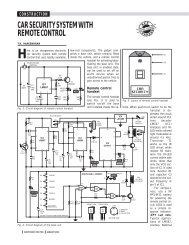Plasma Arc Gasification For Waste Management - Electronics For You
Plasma Arc Gasification For Waste Management - Electronics For You
Plasma Arc Gasification For Waste Management - Electronics For You
You also want an ePaper? Increase the reach of your titles
YUMPU automatically turns print PDFs into web optimized ePapers that Google loves.
ewaste<br />
demoralising effect on the efforts<br />
being put in by the Institute:<br />
“Scientists at the IISc, Bangalore,<br />
have been working on biomass gasification<br />
for more than 20 years. They<br />
have developed fully commercial technology<br />
for producing heat or power<br />
from wastes. Though the technology<br />
is being implemented in several industries,<br />
certain upstream R&D is still<br />
required to modify the technology for<br />
proper utilisation of refuse-derived<br />
fuel.<br />
“We were planning to try this<br />
technology through a pilot plant at a<br />
small town called Chitradurga where<br />
the estimated daily municipal solid<br />
waste production is 44 tonnes (15<br />
tonnes of combustible material). The<br />
plant involves processes like segregation,<br />
drying and pelletisation of<br />
municipal waste before gasification<br />
with about 220 kW of power production.<br />
Of this, about 50 kW was<br />
estimated for in-house consumption.<br />
Under the plan, the plant was to be<br />
set up on a landfill site spread over<br />
an area of 14 hectares on the outskirts<br />
of the town. The project had also<br />
received approval from Chitradurga<br />
municipality.<br />
“However, following a hullabaloo<br />
by well-intentioned environmentalists,<br />
the whole matter is now in a<br />
limbo.”<br />
Import of foreign technologies<br />
for waste management. We should<br />
wisely evaluate all pros and cons<br />
before adopting any imported technology.<br />
We must draw lesson from<br />
the costly blunder that was made<br />
in 1980’s while installing a Danishsupplied<br />
incinerator at Timarpur in<br />
Delhi at a cost of Rs 410 million that<br />
ran for only six days because of high<br />
inerts and ash in the waste supplied.<br />
India lost the case at Hague because<br />
‘suitable waste’ to be provided was<br />
not defined in the agreement. Current<br />
interest and caretaking costs<br />
have totaled a staggering Rs 2 billion<br />
or more. Even worse, this valuable<br />
waste-disposal site has been lost for<br />
decades to the city as the plant is<br />
neither being sold as scrap, nor are<br />
there any takers to take it over for<br />
operation.<br />
Assessing viability of the imported<br />
plasma gasification technology.<br />
<strong>For</strong> assessing the financial viability of<br />
the projects, especially those involving<br />
foreign firms like Startech, the<br />
operating cost, net cost of operation<br />
and capital cost should be taken into<br />
account.<br />
Operating cost. The electrical<br />
power requirement for conversion of<br />
one tonne of municipal solid waste<br />
into vitrified solids and metals, hydrogen<br />
and carbon monoxide gas<br />
averages around 670 units (kWh). At<br />
Rs 3 per unit, the cost of conversion<br />
works out to be Rs 2000 per tonne.<br />
Although one may be able to reduce<br />
the running cost by, say, 75 per cent,<br />
after selling the byproducts, the net<br />
cost of the plant would still be Rs 750<br />
per tonne.<br />
Net cost of operation. As an example,<br />
let us consider Delhi (not entire<br />
NCR) with its current population of<br />
over 15 million. The average garbage<br />
generation may be assumed to be<br />
0.7 kg per person per day (against<br />
Americans’ average of about 2 kg per<br />
person per day). Accordingly, Delhi<br />
would be generating around 10,500<br />
metric tonnes of garbage per day. The<br />
net operational cost would thus be Rs<br />
7.875 million per day (at Rs 750 per<br />
tonne) or Rs 2870 million per annum.<br />
This is in addition to garbage collection<br />
and transportation and other<br />
infrastructure costs.<br />
Capital cost. A Startech plasma<br />
converter that could handle 2000<br />
tonnes of waste daily costs roughly<br />
$250 million. Delhi would require<br />
eight such huge plants at a whopping<br />
cost of $1000 million (roughly Rs 40<br />
billion).<br />
India, being a labour-intensive<br />
country, should employ matching<br />
technologies by segregating the various<br />
types of wastes and treating each<br />
one using indigenously-developed<br />
appropriate technologies. �<br />
Concluded<br />
1 3 0 • Februa ry 2 0 0 9 • electronics for you w w w . e F y m a g . c o m








